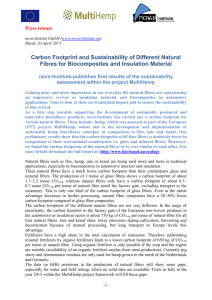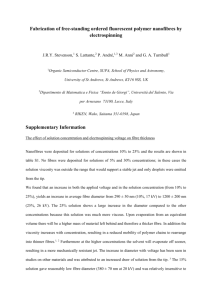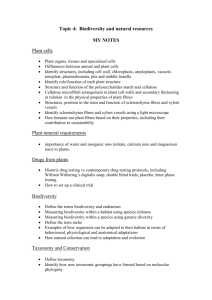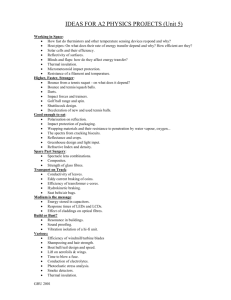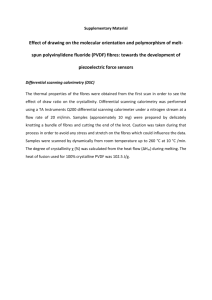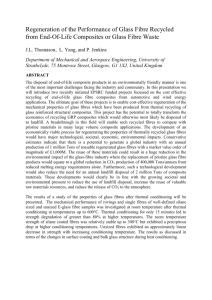International Year of Natural Fibres 2009 Background
advertisement
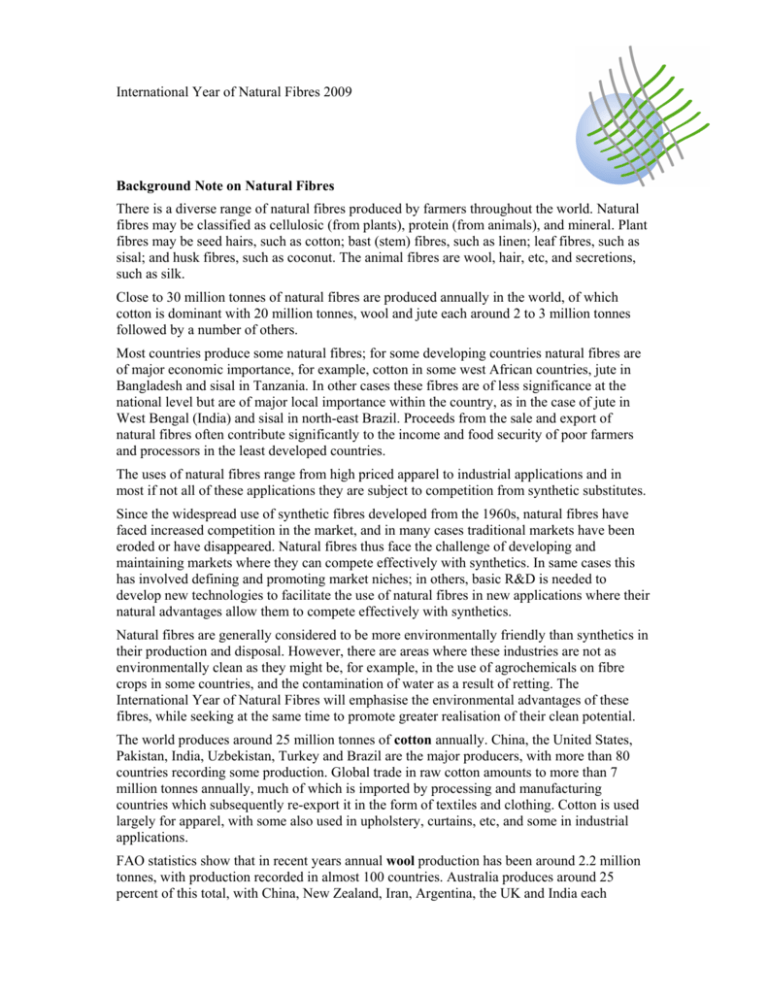
International Year of Natural Fibres 2009 Background Note on Natural Fibres There is a diverse range of natural fibres produced by farmers throughout the world. Natural fibres may be classified as cellulosic (from plants), protein (from animals), and mineral. Plant fibres may be seed hairs, such as cotton; bast (stem) fibres, such as linen; leaf fibres, such as sisal; and husk fibres, such as coconut. The animal fibres are wool, hair, etc, and secretions, such as silk. Close to 30 million tonnes of natural fibres are produced annually in the world, of which cotton is dominant with 20 million tonnes, wool and jute each around 2 to 3 million tonnes followed by a number of others. Most countries produce some natural fibres; for some developing countries natural fibres are of major economic importance, for example, cotton in some west African countries, jute in Bangladesh and sisal in Tanzania. In other cases these fibres are of less significance at the national level but are of major local importance within the country, as in the case of jute in West Bengal (India) and sisal in north-east Brazil. Proceeds from the sale and export of natural fibres often contribute significantly to the income and food security of poor farmers and processors in the least developed countries. The uses of natural fibres range from high priced apparel to industrial applications and in most if not all of these applications they are subject to competition from synthetic substitutes. Since the widespread use of synthetic fibres developed from the 1960s, natural fibres have faced increased competition in the market, and in many cases traditional markets have been eroded or have disappeared. Natural fibres thus face the challenge of developing and maintaining markets where they can compete effectively with synthetics. In same cases this has involved defining and promoting market niches; in others, basic R&D is needed to develop new technologies to facilitate the use of natural fibres in new applications where their natural advantages allow them to compete effectively with synthetics. Natural fibres are generally considered to be more environmentally friendly than synthetics in their production and disposal. However, there are areas where these industries are not as environmentally clean as they might be, for example, in the use of agrochemicals on fibre crops in some countries, and the contamination of water as a result of retting. The International Year of Natural Fibres will emphasise the environmental advantages of these fibres, while seeking at the same time to promote greater realisation of their clean potential. The world produces around 25 million tonnes of cotton annually. China, the United States, Pakistan, India, Uzbekistan, Turkey and Brazil are the major producers, with more than 80 countries recording some production. Global trade in raw cotton amounts to more than 7 million tonnes annually, much of which is imported by processing and manufacturing countries which subsequently re-export it in the form of textiles and clothing. Cotton is used largely for apparel, with some also used in upholstery, curtains, etc, and some in industrial applications. FAO statistics show that in recent years annual wool production has been around 2.2 million tonnes, with production recorded in almost 100 countries. Australia produces around 25 percent of this total, with China, New Zealand, Iran, Argentina, the UK and India each producing more than 50 000 tonnes in 2003. Exports of greasy plus scoured wool amount to around 800 000 tonnes annually and, like cotton, much of this is imported to processing countries for manufacture and subsequent re-export (FAOSTAT). Wool is used largely for apparel, with coarser types used for bedding, for upholstery and for carpets. Production of jute fluctuates from year to year, more perhaps than other fibres, influenced by weather conditions and prices. In the present decade it has ranged from 2.3 to 2.8 million tonnes. Thus the quantity produced generally exceeds that of wool, but in terms of value it ranks far below wool. India produces 60 percent of the world’s jute, with Bangladesh being the other major producer. Other countries, including Myanmar and Nepal, produce much smaller quantities. Kenaf, a fibre very similar to jute, is produced in smaller quantities of around 500 000 tonnes in a number of countries predominantly in Asia. These two fibres have very similar uses, and information on trade and consumption typically combines them. Traditionally jute and kenaf have been used to manufacture packaging materials like hessian, sacking, ropes, twines, carpet backing cloth etc. These applications have been progressively taken over by synthetic materials, and the use of jute and kenaf, in common with other natural fibres in similar markets, has declined. In recent years new technologies have been evolved for the use of jute, as a raw material in the production of high value added and price competitive intermediaries or final products. A host of innovative new products have been developed with high value-addition such as home textiles, composite materials, geo-textiles, paper pulp, technical textiles, chemical products, handicrafts and fashion accessories. In recent years, production of sisal, henequen and similar hard fibres has been around 300 000 tonnes. These fibres are produced from the leaf of the agave and similar species mainly in Africa (Kenya, Tanzania and Madagascar) and Latin America (Brazil, Mexico, Haiti, Venezuela, and Cuba) and in China. Traditionally these fibres have been used for cordage, particularly for baler twine, and for sacking, but more recently, in the face of competition from synthetic materials in these applications, they have been finding markets in a range of uses including carpets, composite materials, and paper pulp. Coir, the fibre from the husk of the coconut, is produced in a great many tropical countries, but reliable data are available only from the few in which coir exports and coir manufactures are of some economic significance. (In many countries, coir is produced in villages on a small scale and does not enter into national statistics). Thus information from the major exporters (India, Sri Lanka, Thailand, Malaysia, Indonesia and a few others) indicate that annual production of coir has been around 450 000 tonnes annually. Coir is used in upholstery and mattresses, for floor mats and matting, brooms and brushes, and in cordage, but it is also finding use in some newer applications such as geotextiles and in composite materials. Silk production has amounted to around 135 000 tonnes annually in recent years. As with many other natural fibres, China is the dominant producer with around 70 percent of global production in 2004. Other producers are mainly in Asia countries, such as India, Vietnam and Thailand, along with Turkmenistan and Uzbekistan in Central Asia, as well as Brazil Silk is produced from cocoons of the silk-producing moth, commonly called the "silkworm." The cocoon, formed from an unbroken fibre secreted from the caterpillar's body, is gathered and the fibre unwound. This unwinding or “reeling” of the fibre is, together with other elements of silk production, very labour intensive. Hemp is a bast fibre similar to flax, kenaf, jute and ramie, used for textiles, cordage and fine paper products. The wood-like core fibre can be used for animal bedding, garden mulch, fuel and an assortment of building materials. Hemp is a distinct variety of the plant species cannabis sativa L. Although both plants are from the species cannabis, hemp contains virtually no tetrahydrocannabinol (THC), the active ingredient in marijuana. Due to the similar leaf shape, hemp is frequently confused with marijuana, and for this reason hemp production is restricted or prohibited in many countries. In 2004 some 85 000 tonnes of hemp fibre were produced globally. China produced almost half of this, with Spain, Korea, the Russian Federation and Chile being other major producers. Abaca is produced from the leaf stalk of a plant closely related to the banana, and is native to the Philippines. Production totals around 80 000 tonnes annually, of which 70 000 tonnes is produced in the Philippines, with the remainder almost entirely in Ecuador. Only small quantities of abaca are now used in traditional cordage applications, with most being pulped for a range of speciality papers for sausage casings, tea bags, coffee filters, cigarette filters and bank notes. Some 75 000 tonnes of flax fibre (linen) is produced annually, two-thirds in China, with the remainder in a number of European countries. Linen is used for a range of textile products, including clothing and other household textiles. Other animal fibres include alpaca, cashmere, angora, mohair, and camel, of which a total of perhaps 30 000 tonnes is produced annually.1 1 Rare animal fibres: Mohair (goat): annual production around 8 000 tonnes, mainly in South Africa, USA and Turkey; Cashmere (goat): 5 000 tonnes annually in China, Mongolia, Iran and Afghanistan; Alpaca: 4 000 tonnes annually from Peru, also Chile and Bolivia; Camel: 2 000 tonnes, mainly from China, Mongolia, Iran and Afghanistan; Angora (rabbit): 8 500 tonnes annually largely in China; Llama: 500 tonnes annually in Peru, Bolivia. Table 1: Value of global exports of selected natural fibres, 2003. Million $ US Abaca (Manila Hemp), raw fibre + manufactures of which the Philippines Coir, raw fibre and manufactures of which India Sri Lanka Cotton, lint of which United States of America Uzbekistan Australia Greece Egypt Flax Fibre+Tow+Waste Hemp Fibre and Tow Jute and other Bast Fibres, raw fibre + manufactures of which Bangladesh India Ramie of which China 84.31 75.17 107.02 67.08 34.74 8 542.2 3 453.7 705.9 595.5 388.8 365.9 550.9 6.5 536.3 293.0 192.5 6.0 5.8 Silk fibre 291.8 of which China 235.5 Sisal and Other Agaves, fibre + manufactures Tanzania 163.1 65.7 13.4 9.3 Wool of which Australia 2 643.2 1 474.3 of which Brazil Kenya TOTAL 12 931.5 Table 2: Value of exports of natural fibres from the top 14 fibre-exporting countries, 2003 United States of America of which cotton Million $ US 3,480 3,453 Australia of which wool cotton 2,071 1,474 595 Uzbekistan of which cotton 708 705 New Zealand of which wool 438 438 China, Mainland of which silk cotton 411 238 134 Greece of which cotton 392 388 Egypt of which cotton 385 365 France of which flax 328 245 Belgium of which flax 273 204 Mali of which cotton 229 229 Brazil of which cotton sisal 226 194 65 India of which cotton 218 205 Côte d'Ivoire of which cotton 178 177 Turkey of which cotton 173 157 iynf-2009@fao.org


